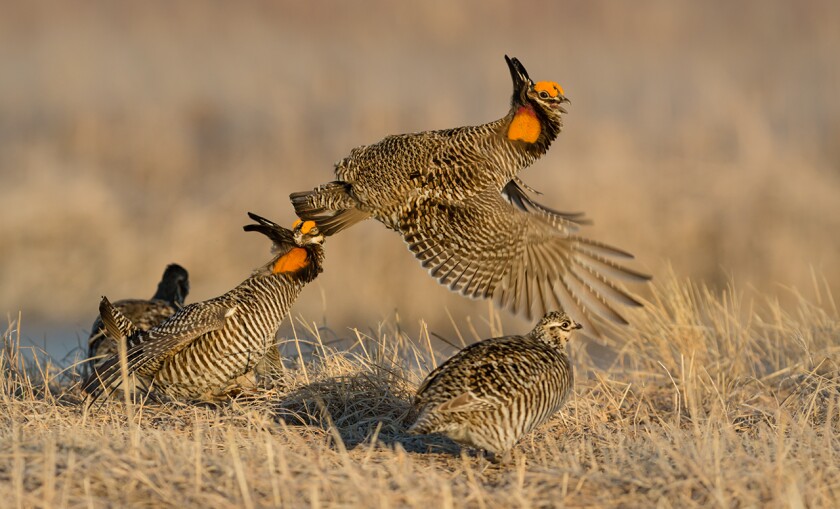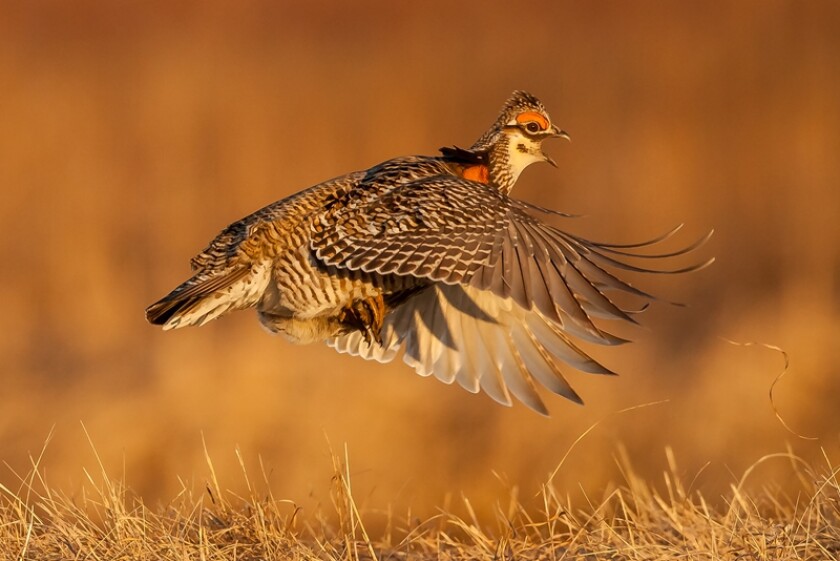NORMAN COUNTY, Minn. — Minnesota Department of Natural Resources area wildlife supervisor Rob Baden waded through a sea of yellow prairie flowers — wild sunflower, goldenrod and black-eyed Susans among others — as he explored a small corner of the Prairie Dunes State Wildlife Management Area.
It is the east portion of Prairie Dunes WMA, which is separated from the west portion by Minnesota Highway 32 north of Gary, about an hour northeast of Moorhead. It is 617 acres of native grasses dotted by 120 shallow wetlands, land that only a few years ago was planted in soybeans and ditched to allow the soggy, sandy loam to drain. Wildlife was at a minimum when the land was used for agriculture.
Now, on a crisp and clear August morning that hints of the coming fall, Baden talks of earlier seeing prairie chicken nests on the ground with broken shells and points to the eastern horizon while explaining where the birds have established spring booming grounds.
"We planted this in late 2017 and didn't have the native grasses on here until 2018. Within one year of the grass being back, we had prairie chickens re-colonizing it," Baden said. "The old adage of 'if you build it, they will come' holds true, I guess."
It is a prairie restoration success story that is becoming increasingly common in Norman and Clay counties in northwestern Minnesota thanks to a fruitful partnership between the Minnesota Prairie Chicken Society and Pheasants Forever, along with other entities like the DNR and the Outdoor Heritage Fund. The partners identify willing landowners, work with them to purchase land and then restore it. It's then gifted to the DNR or the U.S. Fish and Wildlife Service and open to public use, including hunting.
ADVERTISEMENT

Since 2016, the Prairie Chicken Society and Pheasants Forever have partnered on 10 projects totaling 3,133 acres in Norman, Clay and Red Lake counties. It's allowed existing conservation land to be connected with newly acquired land, creating contiguous blocs of habitat in the core prairie chicken area.
While the society's main thrust is protection and re-establishment of the greater prairie chicken that is a favorite of wildlife enthusiasts because of its magnificent spring mating dance — bucket-list viewing for many — the habitat restoration has benefited everything from deer to ducks to sandhill cranes to honeybees to shorebirds like the upland sandpiper and marbled godwit.
"Our mission overlaps with the mission of the Prairie Chicken Society," said Eran Sandquist, Minnesota state coordinator for Pheasants Forever. "Of course our focus pheasants, but our goal is habitat. We want to create complexes and blocs of habitat because we know those are the most beneficial to all types of wildlife."
The PCS is a small, volunteer-only organization whose members mostly live in prairie chicken country. The strength they bring is relationships with landowners and local officials, as well as the knowledge that any restoration project must have the blessing of neighbors and county boards to be successful.

ADVERTISEMENT
Pheasants Forever is a Minnesota-based national organization that brings the expertise, staff and resources to do much of the heavy lifting once a landowner has indicated an interest in selling. It does appraisals and survey work on potential land and actually holds the property after a sale until it can be transferred to the state or federal government.
Combine that partnership with funds available through Minnesota's Outdoor Heritage Fund, made possible by the Clean Water, Land and Legacy Amendment passed by state voters in 2008, and the result is marginal farmland being turned into conservation land to the benefit of prairie chickens and other critters.
"Much of the land we are restoring was in the Conservation Reserve Program, some of it for more than 20 years. But when CRP enrollment changed and crop prices rose, farmers took it out of CRP and tried to turn it into production land again," Baden said. "A lot of it, frankly, isn't very good farmland because it's so wet or too sandy and so the landowners were looking for something to do with it, especially after prices fell."
The result is heaven for prairie chickens, which once numbered in the millions in Minnesota and were "as common as blackbirds," according to the Prairie Chicken Society. The DNR says about 330,000 prairie chickens were harvested by hunters in 1923. But habitat destruction, intensive farming and over-hunting drastically cut their numbers and by 1942 the DNR closed the hunting season. By the 1980s the birds were considered endangered in Minnesota, confined to small areas of the beach ridges of glacial Lake Agassiz.

Today, the state pegs the prairie chicken population at about 5,000 based on spring surveys conducted by the Prairie Chicken Society. But organization president Brian Winter believes the population might be as low as 3,000 because harsh winters and cold, wet springs the last couple of years have carved into the birds' survival.
"I think that just argues more for the work we've been doing. The more habitat you have, the better chance you're going to have at surviving the winter and having successful broods in the spring," Winter said. "The prairie chicken is surviving, but it's not like they are common. It's a small and quite vulnerable population."
ADVERTISEMENT
The key, Winter said, is getting large and permanently connected grasslands. Small parcels of disconnected land aren't nearly as conducive to wildlife production, particularly prairie chickens. That's why the PCS, Pheasants Forever and the DNR are trying to piece together the tiny bits of core remnant prairie and restored grasslands into contiguous blocs of land in Norman and Clay counties.
The partnership last year acquired the Cupido WMA addition, 960 acres of prime conservation land southeast of Twin Valley that hasn't yet been re-seeded into grassland or signed with the familiar green and white WMA border markers. Bulldozers were on the property recently, scraping out sediment-filled wetlands and plugging ditches.
Already, though, dozens of sandhill cranes and Canada geese were using the restored wetlands.
It will soon be another large swath of restored prairie and wetlands, adding to a large complex of public land.
"If you can do that, you give prairie chickens a fighting chance," Winter said. "If you don't have that good base of habitat, you don't have that fighting chance. There are already so many factors going against these birds, from climate change to predators to many other things.
"We'll never have it back like it once was. We recognize this is an area based in agriculture and that's how many of our neighbors make their living. But we're trying to at least give a resemblance of what things were once like. Prairie chickens are a magnificent bird and there is value in having them around," Winter said.

ADVERTISEMENT










